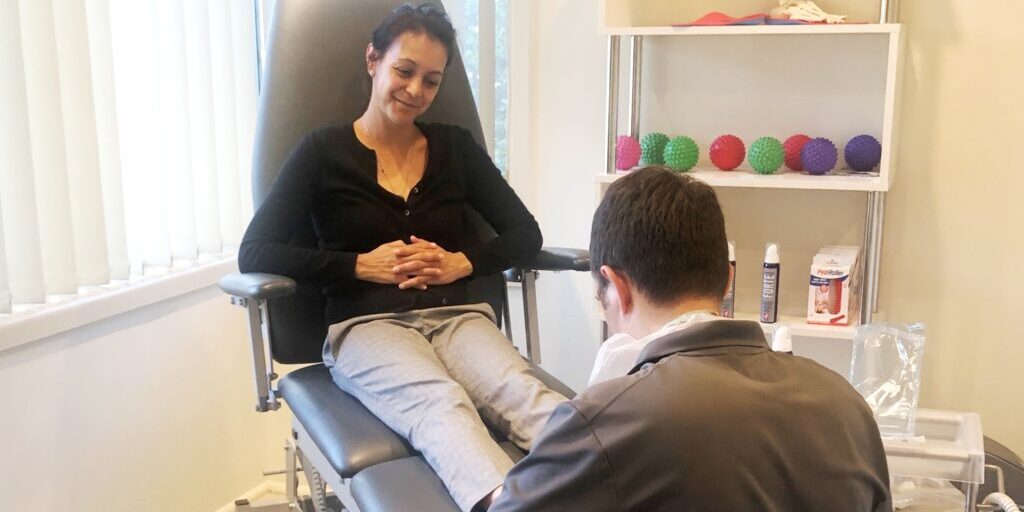Thrive by getting stronger & staying active
And find the help you need to get back to doing what you love.
The Pain
Getting out of bed or standing after sitting can make you anxious because you know you'll experience sharp pain through the bottom of your heel.
The Impact
Sometimes the pain can return during the day too if you’re on your feet a lot. This can mean you avoid walking, exercising, training, or playing the sports you love.
You can feel isolated as you're not out and about or socialising as much, and it can also impact your overall fitness if it goes on for a long time.
If Unresolved
If left untreated, this can lead to more foot pain, hugely impacting all your activity, and making you feel more isolated, and if left for too long, could even require surgery.
Treatment Options
At Sports & Injury Management, I will provide you with a thorough assessment. From there you may require strapping of your foot, be given exercises or advice on footwear or you may need orthotics.
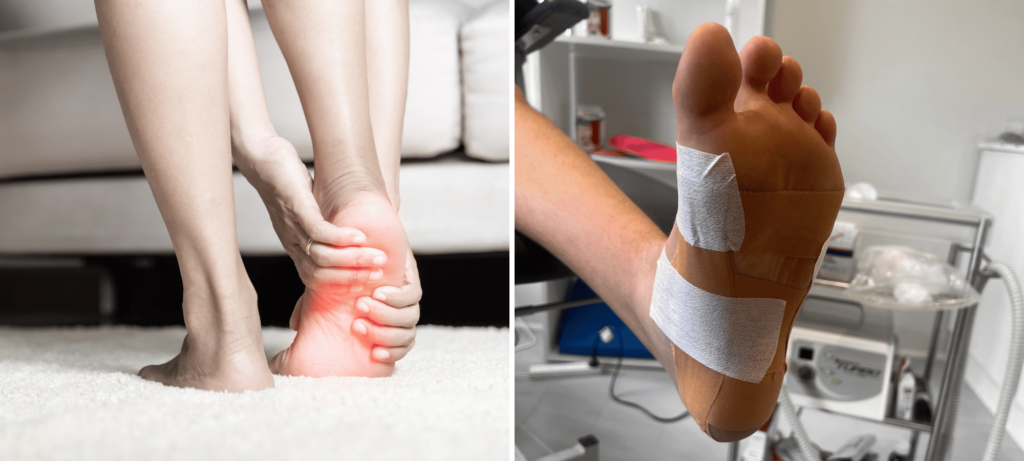
I’ve had lots of patients present with this type of foot pain. Most recently, a lady came to see me who had plantar fasciitis. She was training for the Oxfam walk in Melbourne and was struggling to keep up with her training.
I strapped her feet and gave her exercises to do at home. Over the 8 weeks after her initial assessment, her exercises were changed to continue to challenge her and to develop more strength in her feet and legs.
After 4 weeks she no longer needed her feet strapped and was able to complete the Oxfam walk pain free 
The Pain
Suffering with pain in the back of your heel, can be quite stressful. You may feel a dull ache, or a really sharp pain in the back of your heel or your Achilles tendon. Many patients become apprehensive about doing anything physical, that can trigger the pain.
Some patients feel like it will never get better and worry they'll have to stop exercising.
The Impact
Sharp pain in the back of your heel, can make you feel like you’re unable to train or play sports at 100%, or if you're able to, you'll pull up really sore after and into the next day.
This all reduces your ability to remain at work, be competitive, or just be mobile.
If Unresolved
Ignoring the symptoms may lead to a large lump developing, causing pain with certain shoes that rub or compress the lump.
You may need to give up training or sports until the symptoms resolve. Without proper treatment for your foot pain, it could return quickly. In some cases you may need surgery putting you out of action for much longer.
Treatment Options
At Sports & Injury Management I will provide you with a thorough assessment and accurate diagnosis. From there your treatment options may include strapping of your foot or ankle, heel raises, padding to offload, or dry needling. I may give you exercises, advice on footwear or sometimes orthotics.
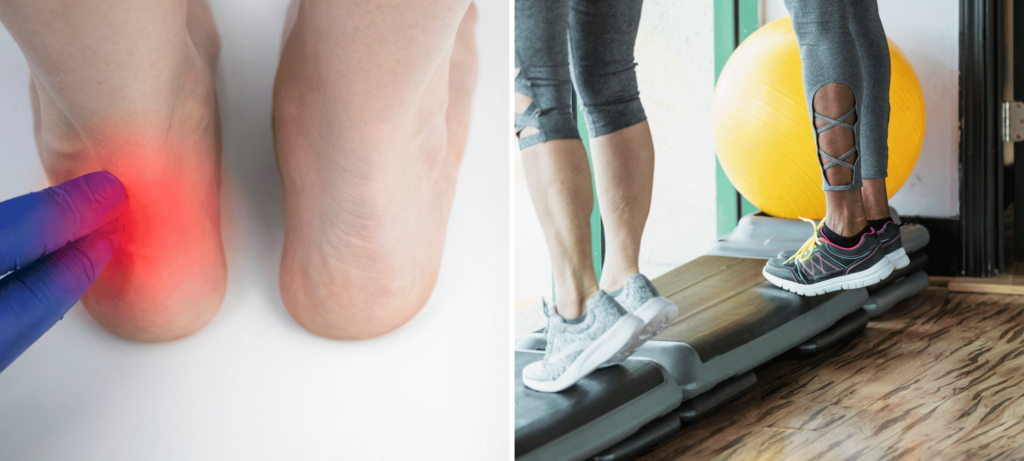
A 30-year-old male runner had been having pain in the right Achilles tendon for 6 weeks. He ran 5 times a week and noticed the pain at the start of his runs, as the Achilles warmed up it eased, but towards the end of his run, the pain returned. It was worse if he ran uphill.
Following a thorough assessment, we agreed on a treatment plan that included a modified running program with more rest days to begin with. I used dry needling on the calf muscles and started the patient with a 2 week strength program to settle his symptoms. Once the symptoms improved significantly, the strength program was changed to build more lower limb strength and increase the endurance of his calf muscles so we could work on stopping the pain towards the end of his runs.
12 weeks after his first appointment, he was able to complete his runs without pain at the start, towards the end, or when running uphill.
The Pain
People who suffer from pain on the inside of the ankle and arch can find it debilitating from the moment they get up and start to walk. It can start as a sharp pain and then an ache throughout the day.
Depending on their activities, they can get a combination of sharp, shooting, or aching pain. It can make people worry about doing simple things like walking the dog or playing with their kids. They have to think twice about what they can do.
The Impact
I’ve known people who have had to stop doing their group exercise classes, stop training for runs, or take an extended period of time out of sport because the pain has been so bad.
Other people have had to take time out of work, or even have their job modified, so that they can work with minimal pain. Wearing certain shoes might also cause more pain.
If Unresolved
In some cases, I’ve seen people have a lot of swelling around the inside of the ankle and arch and this has stopped them being able to wear certain shoes as the pressure from the footwear causes more pain. Other people have had to give up exercising completely.
If left for a long time, the Posterior Tibial tendon can lengthen causing the arch of the foot to flatten. People may then need to be put into a Moon boot so they can walk with minimal to no pain. In extreme cases, surgery has been required.
Treatment Options
Early treatment options for this include strapping of the foot and ankle, a brace to support the ankle, an exercise program, and changes to footwear. Mid to long term treatment options can include custom orthotics, wearing a Moon boot or a Richie Brace (if the arch flattens). The last treatment option would be surgery.
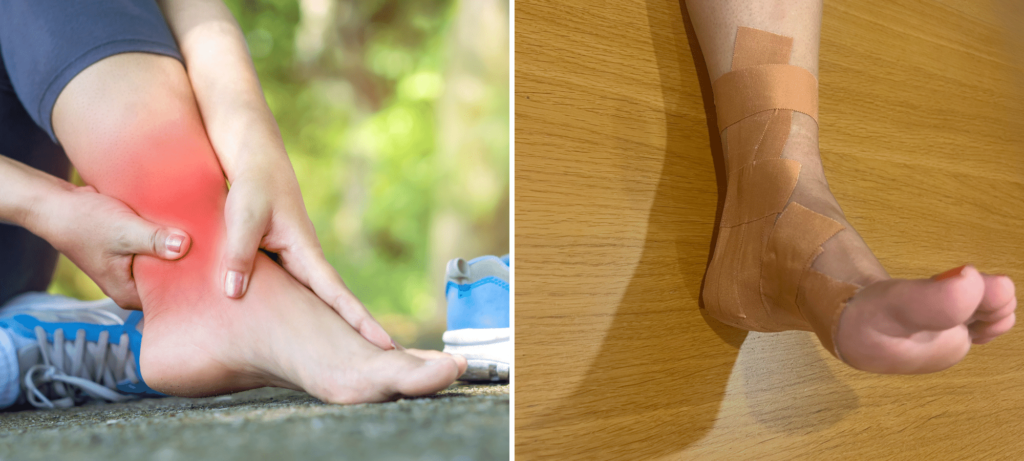
I saw a 28-year-old female who presented with right ankle pain which she'd had for 12 months and was gradually getting worse. The pain was located on the inside of the ankle and arch. She couldn’t walk on the right leg properly first thing in the morning and she found walking downhill caused more pain. She described the pain as an ache, and at times, sharp. She walked on the outside of her foot because she was worried about letting her foot flatten out.
After the assessment, I applied rigid strapping to her foot and inside of the right ankle to reduce the pressure going through the Posterior Tibial tendon. We agreed a modified exercise program that included cycling, swimming, and walking on a flat surface. She was given exercises to reduce her symptoms and strengthen her lower leg. She was given footwear advice and custom orthotics to provide long term pressure relief on the Posterior Tibial tendon.
With the combination of orthotics and exercises, this patient was back walking around Diamond Creek and doing exercise classes just 4 months after her first appointment.
The Pain
If you have pain in the ball of your foot, or close to your toes, or if you notice one or two toes feel numb, or like your sock is scrunching up under your toes, you might have a Morton’s neuroma or a plantar plate tear. Both can cause sharp pain, or feel like you have a small pebble in your foot when you stand or walk. There’s also the stress of not being able to do your daily activities without pain.
The Impact
These conditions can have a severe negative impact on people's lives. Patients often feel frustrated at not being able to wear certain shoes, as this can worsen the pain, which often stops people from walking, exercising, or doing activities they enjoy.
If Unresolved
Leaving these conditions untreated can create longer term problems.
Struggling with day to day pain can be demoralising, especially if your mobility or ability to do the things you love is impacted.
Some patients have to give up certain activities, throw away good footwear, or become socially isolated because of their lack of mobility.
Long term numbness in the toes can also result in changes to the shape or position of the toes requiring surgery.
Treatment Options
Treatment for Morton’s neuroma or a plantar plate tear can involve padding on the foot and/or strapping the affected toes. Exercises can also be used to strengthen the foot and help with the load being applied through it.
If this approach works replaceable padding can be provided. Changes in footwear and orthotics are also recommended. A referral for steroid injections or surgery is sometimes needed.
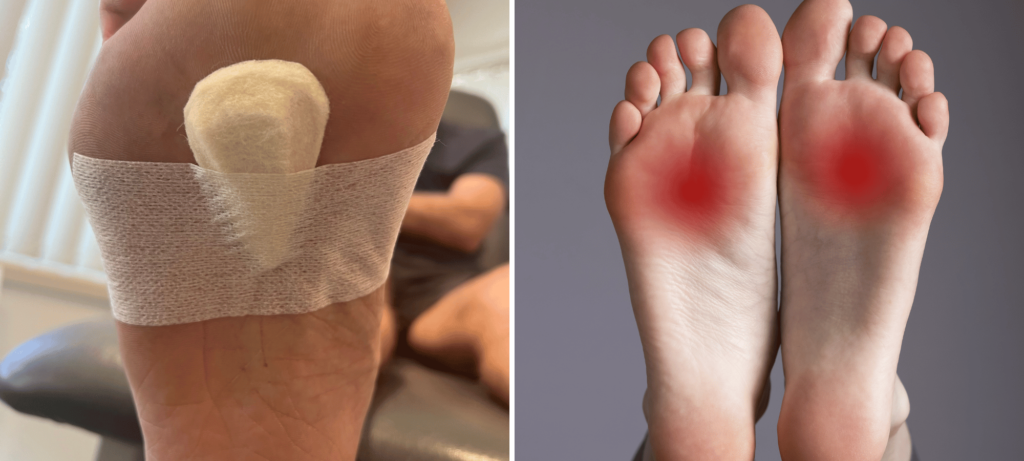
A 70-year-old gentleman presented with pain in the ball of the left foot which had been ongoing for 6 weeks. He advised he was struggling to walk without pain and that it was impacting on his goal of being able to go out and walk every day for general fitness.
From the assessment I was able to determine that he had a Morton’s neuroma and plantar plate tear. I strapped his toe to keep it straight and reduce the pressure being applied to the plantar plate. I then applied a pad to deflect pressure away from the ball of the foot. He was referred for an ultrasound to confirm the diagnosis.
He returned a week later with his ultrasound report which confirmed the diagnosis. He reported that the padding and strapping worked well and he had no pain until he took the padding and strapping off.
We agreed that the next step was to take a plaster mould of his feet to get custom orthotics which would provide long term relief and reduce the pressure on the ball of his foot while helping the plantar plate repair. He was shown how to apply the strapping to the toe and extra padding was given so he could do this himself until his orthotics arrived.
He picked up his orthotics 2 weeks later and found them comfortable and he had no pain when walking with them in his shoes. On his phone call check-up a couple of weeks after getting them, he advised his pain was no longer present and that he was back out walking every day which made him feel happy again.
The Pain
A throbbing, sharp, or aching pain can be commonly experienced in the big toe after an injury. Someone might have stood on it, or you might have tripped over or hit it on a solid object. The pain can make you limp and feel uncomfortable.
The Impact
Toe pain can leave you frustrated at not being able to walk pain free. The pain can also limit the shoes you can wear, or make walking barefoot difficult. If you play sports that involve running, jumping, or kicking, the pain can often stop you from being able to participate for fear of making it worse.
If Unresolved
If left untreated or if you continue to do things that aggravate it, this can lead to more swelling of the joint causing more pain. In some cases, you may need to wear a Moon boot for a few weeks which will result in you having to stop taking part in any exercise or stop playing sport.
Treatment Options
Treatment options for this include padding and strapping, modified rest, changes to footwear, exercises and orthotics. Depending on how painful the toe is, you may need to use a Moon boot and in extreme cases require surgical intervention.
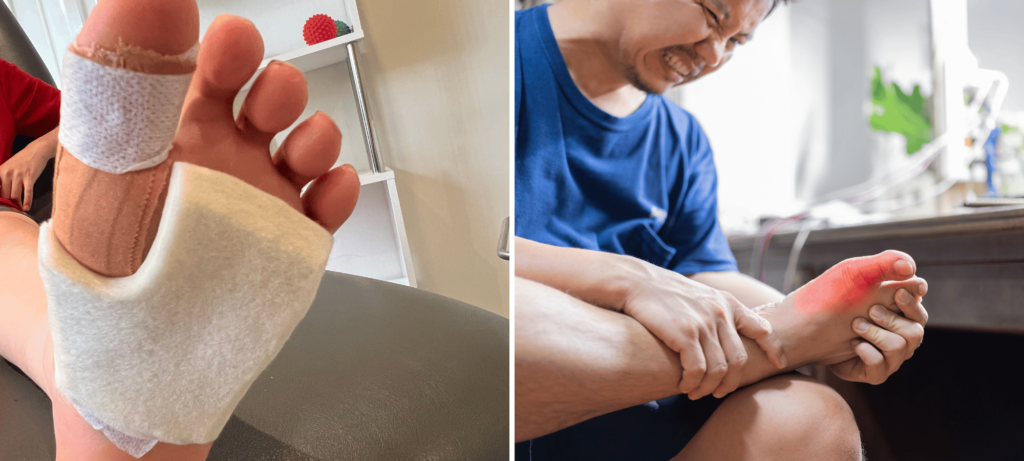
I recently treated a 14-year-old Melbourne Victory youth team soccer player who had pain and swelling in the left big toe, as the result of landing awkwardly during a tackle.
The big toe joint was swollen and warm to the touch. I strapped the toe to limit movement and then applied a pad to offload it. He reduced running activities in training and limited exposure to kicking the ball with that foot.
Seven days later his pain had improved significantly. I modified his soccer boots slightly to provide longer-term relief and he was taught to strap his toe before matches.
Three weeks later the swelling and pain had gone, and he was fully back to playing soccer.
The Pain
Aching pain in the arch and across the top of your foot, aka midfoot arthritis, can happen as we get older. Depending on what you are doing, sometimes it can be a sharp pain that stops you in your tracks. Often it can make you wince as you try to do your daily activities. Over time this will affect your mood and motivation to do anything.
The Impact
This type of foot pain, really limits your ability to walk, no matter what shoes you wear, and even if you go barefoot. It can stop you from doing the activities you like, such as walking your dog, playing with your children or grandchildren, any kind of exercise, or even being at work. Mentally it can also be draining and worrying.
If Unresolved
If left untreated, you could end up in more pain, being increasingly immobile, or completely debilitated, and isolated.
Treatment Options
Treatment options for midfoot arthritis include, padding & strapping, changes to footwear, medication and orthotics.
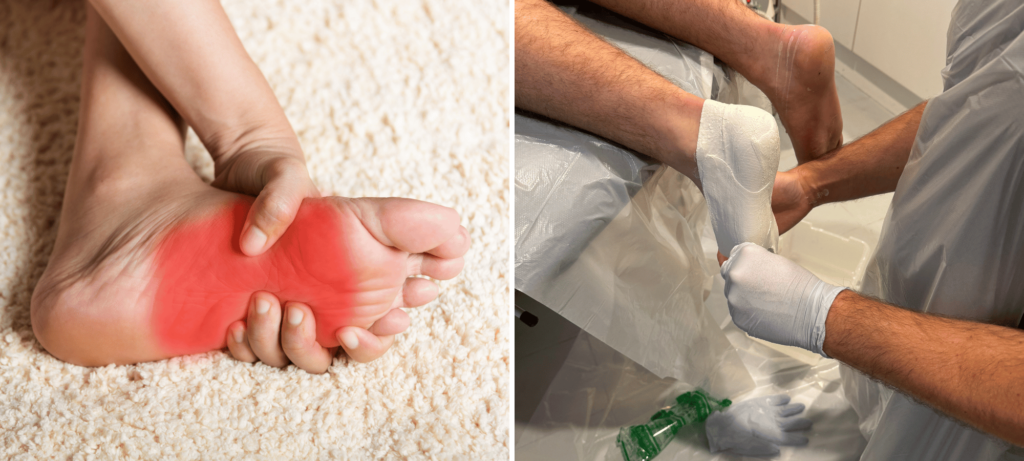
A 55 year old carpenter presented with pain across the top of both his feet. He was finding it hard to get through his working day due to the constant pain and was having to take time off work or take anti-inflammatory medication.
To kickstart his recovery, I taped his feet which immediately helped reduce the pain. I then made custom orthotics for him to wear in his work boots and gave him exercises to help strengthen his feet and legs.
Within a month of wearing the orthotics and doing his exercises, he was able to work all day without taking medication and he had no further pain.
Suffering from any of these conditions?
Take the next step to living a better life
FAQs for Sports & Injury Management, Diamond Creek
Yes absolutely!
I love to help people suffering from Achilles tendinopathy and have helped many people with this in my time practicing as a Podiatrist.
Plantar fasciitis is a very common problem. It affects 1,000's of people. Based on an Australian population study of 3206 participants, the prevalence of heel pain was 3.6%. Other studies have found it to be as high as 9.6%.
Your first appointment will cost $125 for a detailed and thorough assessment and diagnosis session. Follow-up appointments are usually $85, but if an extended appointment is needed, the price is $105.
Depending on your level of private health insurance (if you have this), you may be covered for a percentage of the total appointment cost. If you have a Medicare Chronic Disease Management plan from your GP, Medicare will reimburse you $60.35.
The cost for this will vary depending on what stage your injury is at and what treatment is required. If your symptoms started recently, you may need just 4 appointments, but if it's more long standing, you will need more appointments and custom orthotics to get you a solution. So the price could range from $400-$1400.
Disclaimer
The nature of individual health problems means that previous success in helping patients with these problems is no indicator of a guaranteed positive outcome for everyone. We are unable to predict or guarantee outcomes for any patients.
Sports & Injury Management
122 Main Hurstbridge Road
Diamond Creek
VIC 3089

